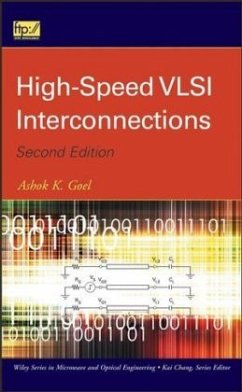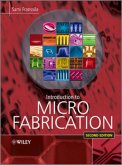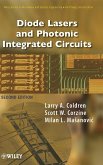Ashok K Goel
High-Speed VLSI Interconnections
Ashok K Goel
High-Speed VLSI Interconnections
- Gebundenes Buch
- Merkliste
- Auf die Merkliste
- Bewerten Bewerten
- Teilen
- Produkt teilen
- Produkterinnerung
- Produkterinnerung
This Second Edition focuses on emerging topics and advances in the field of VLSI interconnections
In the decade since High-Speed VLSI Interconnections was first published, several major developments have taken place in the field. Now, updated to reflect these advancements, this Second Edition includes new information on copper interconnections, nanotechnology circuit interconnects, electromigration in the copper interconnections, parasitic inductances, and RLC models for comprehensive analysis of interconnection delays and crosstalk.
Each chapter is designed to exist independently or as…mehr
Andere Kunden interessierten sich auch für
![Interconnect Analysis and Synthesis Interconnect Analysis and Synthesis]() Chung-Kuan ChengInterconnect Analysis and Synthesis162,99 €
Chung-Kuan ChengInterconnect Analysis and Synthesis162,99 €![Introduction to Microfabrication Introduction to Microfabrication]() Sami FranssilaIntroduction to Microfabrication94,99 €
Sami FranssilaIntroduction to Microfabrication94,99 €![Low-Voltage Soi CMOS VLSI Devices and Circuits Low-Voltage Soi CMOS VLSI Devices and Circuits]() James B. KuoLow-Voltage Soi CMOS VLSI Devices and Circuits173,99 €
James B. KuoLow-Voltage Soi CMOS VLSI Devices and Circuits173,99 €![Verilog Coding for Logic Synthesis Verilog Coding for Logic Synthesis]() Weng F. LeeVerilog Coding for Logic Synthesis157,99 €
Weng F. LeeVerilog Coding for Logic Synthesis157,99 €![Diode Lasers 2e. Diode Lasers 2e.]() Larry A. ColdrenDiode Lasers 2e.156,99 €
Larry A. ColdrenDiode Lasers 2e.156,99 €![Digital VLSI Design and Simulation with Verilog Digital VLSI Design and Simulation with Verilog]() Suman Lata TripathiDigital VLSI Design and Simulation with Verilog124,99 €
Suman Lata TripathiDigital VLSI Design and Simulation with Verilog124,99 €![Mixed-Signal Systems Mixed-Signal Systems]() Andrzej HandkiewiczMixed-Signal Systems170,99 €
Andrzej HandkiewiczMixed-Signal Systems170,99 €-
-
-
This Second Edition focuses on emerging topics and advances in the field of VLSI interconnections
In the decade since High-Speed VLSI Interconnections was first published, several major developments have taken place in the field. Now, updated to reflect these advancements, this Second Edition includes new information on copper interconnections, nanotechnology circuit interconnects, electromigration in the copper interconnections, parasitic inductances, and RLC models for comprehensive analysis of interconnection delays and crosstalk.
Each chapter is designed to exist independently or as a part of one coherent unit, and several appropriate exercises are provided at the end of each chapter, challenging the reader to gain further insight into the contents being discussed. Chapter subjects include:
_
Preliminary Concepts
_
Parasitic Resistances, Capacitances, and Inductances
_
Interconnection Delays
_
Crosstalk Analysis
_
Electromigration-Induced Failure Analysis
_
Future Interconnections
High-Speed VLSI Interconnections, Second Edition is an indispensable reference for high-speed VLSI designers, RF circuit designers, and advanced students of electrical engineering.
In the decade since High-Speed VLSI Interconnections was first published, several major developments have taken place in the field. Now, updated to reflect these advancements, this Second Edition includes new information on copper interconnections, nanotechnology circuit interconnects, electromigration in the copper interconnections, parasitic inductances, and RLC models for comprehensive analysis of interconnection delays and crosstalk.
Each chapter is designed to exist independently or as a part of one coherent unit, and several appropriate exercises are provided at the end of each chapter, challenging the reader to gain further insight into the contents being discussed. Chapter subjects include:
_
Preliminary Concepts
_
Parasitic Resistances, Capacitances, and Inductances
_
Interconnection Delays
_
Crosstalk Analysis
_
Electromigration-Induced Failure Analysis
_
Future Interconnections
High-Speed VLSI Interconnections, Second Edition is an indispensable reference for high-speed VLSI designers, RF circuit designers, and advanced students of electrical engineering.
Produktdetails
- Produktdetails
- Wiley Series in Microwave and Optical Engineering 1
- Verlag: Wiley & Sons
- 2. Aufl.
- Seitenzahl: 432
- Erscheinungstermin: 17. September 2007
- Englisch
- Abmessung: 236mm x 165mm x 26mm
- Gewicht: 735g
- ISBN-13: 9780471780465
- ISBN-10: 0471780464
- Artikelnr.: 22801160
- Herstellerkennzeichnung
- Libri GmbH
- Europaallee 1
- 36244 Bad Hersfeld
- gpsr@libri.de
- Wiley Series in Microwave and Optical Engineering 1
- Verlag: Wiley & Sons
- 2. Aufl.
- Seitenzahl: 432
- Erscheinungstermin: 17. September 2007
- Englisch
- Abmessung: 236mm x 165mm x 26mm
- Gewicht: 735g
- ISBN-13: 9780471780465
- ISBN-10: 0471780464
- Artikelnr.: 22801160
- Herstellerkennzeichnung
- Libri GmbH
- Europaallee 1
- 36244 Bad Hersfeld
- gpsr@libri.de
AShok k. Goel, PhD, is Associate Professor of Electrical Engineering at Michigan Technological University. He is the author of more than thirty journal publications and numerous conference proceedings. His research interests include nanotechnology circuit design, high-speed VLSI interconnections, device physics and modeling, and semiconductor TCAD.
Preface.
1. Preliminary Concepts and More.
1.1 Interconnections for VLSI Applications.
1.1.1 Metallic Interconnections - Multilevel, Multilayer and Multipath
Configurations.
1.1.2 Optical Interconnections.
1.1.3 Superconducting Interconnections.
1.2 Copper Interconnections.
1.2.1 Advantages of Copper Interconnections.
1.2.2 Challenges Posed by Copper Interconnections.
1.2.3 Fabrication Processes for Copper Interconnections.
1.2.4 Damascene Processing of Copper Interconnections.
1.3 Method of Images.
1.4 Method of Moments.
1.5 Even and Odd Mode Capacitances.
1.5.1 Two Coupled Conductors.
1.5.2 Three Coupled Conductors.
1.6 Transmission Line Equations.
1.7 Miller's Theorem.
1.8 Inverse Laplace Transformation.
1.9 A Resistive Interconnection as a Ladder Network.
1.9.1 Open Circuit Interconnection.
1.9.2 Short Circuited Interconnection.
1.9.3 Application of the Ladder Approximation to a Multipath
Interconnection.
1.10 Propagation Modes in a Microstrip Interconnection.
1.11 Slow-Wave Mode Propagation.
1.11.1 Quasi-TEM Analysis.
1.11.2 Comparison with Experimental Results.
1.12 Propagation Delays.
Exercises.
References.
2. Parasitic Resistances, Capacitances and Inductances.
2.1 Parasitic Resistances - General Considerations.
2.2 Parasitic Capacitances - General Considerations.
2.2.1 Parallel Plate Capacitance.
2.2.2 Fringing Capacitances.
2.2.3 Coupling Capacitances.
2.3 Parasitic Inductances - General Considerations.
2.3.1 Self and Mutual Inductances.
2.3.2 Partial Inductances.
2.3.3 Methods for Inductance Extraction.
2.3.4 Effect of Inductances on Interconnection Delays.
2.4 Approximate Formulas for Capacitances.
2.4.1 Single Line on a Ground Plane.
2.4.2 Two Lines on a Ground Plane.
2.4.3 Three Lines on a Ground Plane.
2.4.4 Single Plate with Finite Dimensions on a Ground Plane.
2.5 The Green's Function Method - Using Method of Images.
2.5.1 Green's Function Matrix for Interconnections Printed on the
Substrate.
2.5.2 Green's Function Matrix for Interconnections Embedded in the
Substrate.
2.5.3 Application of the Method of Moments.
2.5.4 Even and Odd Mode Capacitances.
2.5.5 Ground and Coupling Capacitances.
2.5.6 The Program IPCSGV.
2.5.7 Parametric Dependence of Interconnection Capacitances.
2.6 The Green's Function Method - Fourier Integral Approach.
2.6.1 Green's Function for Multilevel Interconnections.
2.6.2 Multiconductor Interconnection Capacitances.
2.6.3 Piecewise Linear Charge Distribution Function.
2.6.4 Calculation of Interconnection Capacitances.
2.7 The Network Analogue Method.
2.7.1 Representation of Subregions by Network Analogues.
2.7.2 Diagonalized System for Single Level Interconnections.
2.7.3 Diagonalized System for Multilevel Interconnections.
2.7.4 Interconnection Capacitances and Inductances.
2.7.5 The Program "ICIMPGV".
2.7.6 Parametric Dependence of Interconnection Capacitances.
2.7.7 Parametric Dependence of Interconnection Inductances.
2.8 Simplified Formulas for Interconnection Capacitances and Inductances on
Silicon and GaAs Substrates.
2.8.1 Line Capacitances and Inductances.
2.8.2 Coupling Capacitances and Inductances.
2.9 Inductance Extraction Using FastHenry.
2.9.1 The Program "FastHenry".
2.9.2 Extraction Results Using FastHenry.
2.10 Copper Interconnections - Resistance Modeling.
2.10.1 Effect of Surface/Interface Scattering on the Interconnection
Resistivity.
2.10.2 Effect of Diffusion Barrier on the Interconnection Resistivity.
2.11 Electrode Capacitances in a GaAs MESFET - An Application of the
Program IPCSGV.
2.11.1 Ground and Coupling Capacitances.
2.11.2 The Program "EPCSGM".
2.11.3 Dependence on MESFET Dimensions.
2.11.4 Comparison with Internal MESFET Capacitances.
Exercises.
References.
3. Interconnection Delays.
3.1 Metal-Insulator-Semiconductor Microstrip Line Model of an
Interconnection.
3.1.1 The Model.
3.1.2 Simulation Results.
3.2 Transmission Line Analysis of Single Level Interconnections.
3.2.1 The Model.
3.2.2 The Program "PDSIGV".
3.2.3 Dependence on Interconnection Parameters.
3.3 Transmission Line Analysis of Parallel Multilevel Interconnections.
3.3.1 The Model.
3.3.2 Numerical Simulation Results.
3.4 Analysis of Crossing Interconnections.
3.4.1 Simplified Analysis of Crossing Interconnections.
3.4.2 Comprehensive Analysis of Crossing Interconnections.
3.4.3 The Program "SPBIGV".
3.4.4 Simulation Results Using SPBIGV3.5Parallel Interconnections Modeled
as Multiple Coupled Microstrips.
3.5.1 The Model.
3.5.2 Simulation Results.
3.6 Modeling of Lossy Parallel and Crossing Interconnections as Coupled
Lumped Distributed Systems.
3.6.1 The Model.
3.6.2 Simulation Results.
3.7 Very High Frequency Losses in a Microstrip Interconnection.
3.7.1 The Model.
3.7.2 Simulation Results.
3.7.3 Interconnection Delays With the High-Frequency Effects.
3.8 Compact Expressions for Interconnection Delays.
3.8.1 The RC Interconnection Model.
3.8.2 The RLC Interconnection Model - A Single Semi-Infinite Line.
3.8.3 The RLC Interconnection Model - A Single Finite Line.
3.8.4 Single RLC Interconnection - Delay Time.
3.8.5 Two and Three Coupled RLC Interconnections - Delay Times.
3.9 Interconnection Delays in Multilayer Integrated Circuits.
3.9.1 The Simplified Model.
3.9.2 Simulation Results and Discussion.
3.10 Active Interconnections.
3.10.1 Interconnection Delay Model.
3.10.2 Active Interconnection Driven by Minimum Size Inverters.
3.10.3 Active Interconnection Driven by Optimum Size Inverters.
3.10.4 Active Interconnection Driven by Cascaded Inverters.
3.10.5 Dependence of Propagation Time on the Interconnection Driving
Mechanism.
Exercises.
References.
4. Crosstalk Analysis.
4.1Lumped Capacitance Approximation.
4.2Coupled Multiconductor MIS Microstrip Line Model of Single Level
Interconnections.
4.2.1 The Model.
4.2.2 Numerical Simulations.
4.2.3 Crosstalk Reduction.
4.3 Frequency Domain Modal Analysis of Single Level Interconnections.
4.3.1 The General Technique.
4.3.2 Two-Line System.
4.3.3 Three-Line System.
4.3.4 Four-Line System.
4.3.5 Simulation Results.
4.4 Transmission Line Analysis of Parallel Multilevel Interconnections.
4.4.1 The Model.
4.4.2 The Program "DCMPVI".
4.4.3 Numerical Simulations Using DCMPVI.
4.5 Analysis of Crossing Interconnections.
4.5.1 Effect of Crossing Interconnections.
4.5.2 Comprehensive Analysis of Crossing Interconnections.
4.6 Compact Expressions for Crosstalk Analysis.
4.6.1 Distributed RC Model for Two Coupled Interconnections.
4.6.2 Distributed RLC Model for Two Coupled Interconnections.
4.6.3 Distributed RLC Model for Three Coupled Interconnections.
4.7 Multiconductor Buses in GaAs High-Speed Logic Circuits.
4.7.1 The Model.
4.7.2 Lossless MBUS with Cyclic Boundary Conditions.
4.7.3 Simulation Results.
Exercises.
References.
5. Electromigration-Induced Failure Analysis.
5.1 Electromigration in VLSI Interconnection Metallizations - An Overview.
5.1.1 Problems Caused by Electromigration.
5.1.2 Electromigration Mechanism and Factors.
5.1.3 Electromigration Under Pulsed-DC and AC Conditions.
5.1.4 Testing and Monitoring of Electromigration.
5.1.5 General Guidelines for Testing Electromigration.
5.1.6 Reduction of Electromigration.
5.2 Models of IC Reliability.
5.2.1 Arrhenius Model.
5.2.2 Mil-Hdbk-217D Model.
5.2.3 Series Model.
5.2.4 Series-Parallel Model.
5.3 Modeling of Electromigration Due to Repetitive Pulsed Currents.
5.3.1 Modeling of Physical Processes.
5.3.2 First-Order Model Development.
5.3.3 Modeling Results for DC Currents.
5.3.4 Modeling Results for Pulsed Currents.
5.4 Electromigration in the Copper Interconnections.
5.4.1 Electromigration Under DC Conditions.
5.4.2 Electromigration Under Pulsed DC Condition.
5.4.3 Electromigration Under Bipolar AC Conditions.
5.5 Failure Analysis of VLSI Interconnection Components.
5.5.1 Reduction of Components into Straight Segments.
5.5.2 Calculation of MTF and Lognormal Standard Deviation.
5.5.3 The Program "EMVIC".
5.5.4 Simulation Results Using EMVIC.
5.6 Computer-Aided Failure Analysis.
5.6.1 "RELIANT" for Reliability of VLSI Interconnections.
5.6.2 "SPIDER" for Checking Current Density and Voltage Drops in the
Interconnection Metallizations.
Exercises.
References.
6. Future Interconnections.
6.1 Optical Interconnections.
6.1.1 Advantages of Optical Interconnections.
6.1.2 Systems Issues and Challenges.
6.1.3 Material Processing Issues and Challenges.
6.1.4 Design Issues and Challenges.
6.2 Transmission Line Models of Lossy Waveguide Interconnections.
6.2.1 Lossy Waveguide with Single Propagating Wave.
6.2.2 Equivalent Circuits for Waveguide Drivers and Loads.
6.2.3 Lossy Waveguide in an Inhomogenous Medium.
6.3 Superconducting Interconnections.
6.3.1 Advantages of Superconducting Interconnections.
6.3.2 Propagation Characteristics of Superconducting Interconnections.
6.3.3 Comparison with Normal Metal Interconnections.
6.4 Nanotechnology Circuit Interconnections - Potential Technologies.
6.4.1 Silicon Nanowires and Metallic Interconnections.
6.4.2 Nanotube Interconnections.
6.4.3 Quantum Cell Based Wireless Interconnections.
6.5 Nanotube Integrated Circuits.
6.5.1 Nanotube Interconnections and Vias.
6.5.2 Comparison of Nanotube and Copper Interconnections.
6.5.3 Nanotubes for High Frequency Applications.
Exercises.
References.
CD-ROM.
Appendix 2.1: Listing of the Program "IPCSGV" for Calculating the Parasitic
Capacitances for Single Level Interconnections on GaAs-Based VLSI Using the
Green's Function Method.
Appendix 2.2: Listing of the Program "ICIMPGV" for Calculating the
Parasitic Capacitances and Inductances for Multilevel Interconnections on
GaAs-Based VLSI Using the Network Analogue Method.
Appendix 2.3: Listing of the Program "EPCSGM" for Calculating the Electrode
Parasitic Capacitances in a Single-Gate GaAs MESFET.
Appendix 3.1: Listing of the Program "PDSIGV" for Calculating the
Propagation Delays in the Single Level Interconnections on GaAs-Based VLSI.
Appendix 3.2: Listing of the Program "IPDMSR" for Calculating the
Propagation delays in an Interconnection Driven by Minimum Size Repeaters.
Appendix 3.3: Listing of the Program "IPDOSR" for Calculating the
Propagation delays in an Interconnection Driven by Optimum Size Repeaters.
Appendix 3.4: Listing of the Program "IPDCR" for Calculating the
Propagation delays in an Interconnection Driven by Cascaded Repeaters.
Appendix 4.1: Listing of the Program "DCMPVI" for Delay and Crosstalk
Analysis of Multilevel Parallel VLSI Interconnections.
Appendix 4.2: Listing of the Program "SPBIGV" for Signal Propagation
Analysis of Bilevel Crossing Interconnections on GaAs-Based VLSI.
Appendix 5.1: Listing of the Program "EMVIC" for Electromigration-Induced
Failure Analysis of VLSI Interconnection Components.
Index.
1. Preliminary Concepts and More.
1.1 Interconnections for VLSI Applications.
1.1.1 Metallic Interconnections - Multilevel, Multilayer and Multipath
Configurations.
1.1.2 Optical Interconnections.
1.1.3 Superconducting Interconnections.
1.2 Copper Interconnections.
1.2.1 Advantages of Copper Interconnections.
1.2.2 Challenges Posed by Copper Interconnections.
1.2.3 Fabrication Processes for Copper Interconnections.
1.2.4 Damascene Processing of Copper Interconnections.
1.3 Method of Images.
1.4 Method of Moments.
1.5 Even and Odd Mode Capacitances.
1.5.1 Two Coupled Conductors.
1.5.2 Three Coupled Conductors.
1.6 Transmission Line Equations.
1.7 Miller's Theorem.
1.8 Inverse Laplace Transformation.
1.9 A Resistive Interconnection as a Ladder Network.
1.9.1 Open Circuit Interconnection.
1.9.2 Short Circuited Interconnection.
1.9.3 Application of the Ladder Approximation to a Multipath
Interconnection.
1.10 Propagation Modes in a Microstrip Interconnection.
1.11 Slow-Wave Mode Propagation.
1.11.1 Quasi-TEM Analysis.
1.11.2 Comparison with Experimental Results.
1.12 Propagation Delays.
Exercises.
References.
2. Parasitic Resistances, Capacitances and Inductances.
2.1 Parasitic Resistances - General Considerations.
2.2 Parasitic Capacitances - General Considerations.
2.2.1 Parallel Plate Capacitance.
2.2.2 Fringing Capacitances.
2.2.3 Coupling Capacitances.
2.3 Parasitic Inductances - General Considerations.
2.3.1 Self and Mutual Inductances.
2.3.2 Partial Inductances.
2.3.3 Methods for Inductance Extraction.
2.3.4 Effect of Inductances on Interconnection Delays.
2.4 Approximate Formulas for Capacitances.
2.4.1 Single Line on a Ground Plane.
2.4.2 Two Lines on a Ground Plane.
2.4.3 Three Lines on a Ground Plane.
2.4.4 Single Plate with Finite Dimensions on a Ground Plane.
2.5 The Green's Function Method - Using Method of Images.
2.5.1 Green's Function Matrix for Interconnections Printed on the
Substrate.
2.5.2 Green's Function Matrix for Interconnections Embedded in the
Substrate.
2.5.3 Application of the Method of Moments.
2.5.4 Even and Odd Mode Capacitances.
2.5.5 Ground and Coupling Capacitances.
2.5.6 The Program IPCSGV.
2.5.7 Parametric Dependence of Interconnection Capacitances.
2.6 The Green's Function Method - Fourier Integral Approach.
2.6.1 Green's Function for Multilevel Interconnections.
2.6.2 Multiconductor Interconnection Capacitances.
2.6.3 Piecewise Linear Charge Distribution Function.
2.6.4 Calculation of Interconnection Capacitances.
2.7 The Network Analogue Method.
2.7.1 Representation of Subregions by Network Analogues.
2.7.2 Diagonalized System for Single Level Interconnections.
2.7.3 Diagonalized System for Multilevel Interconnections.
2.7.4 Interconnection Capacitances and Inductances.
2.7.5 The Program "ICIMPGV".
2.7.6 Parametric Dependence of Interconnection Capacitances.
2.7.7 Parametric Dependence of Interconnection Inductances.
2.8 Simplified Formulas for Interconnection Capacitances and Inductances on
Silicon and GaAs Substrates.
2.8.1 Line Capacitances and Inductances.
2.8.2 Coupling Capacitances and Inductances.
2.9 Inductance Extraction Using FastHenry.
2.9.1 The Program "FastHenry".
2.9.2 Extraction Results Using FastHenry.
2.10 Copper Interconnections - Resistance Modeling.
2.10.1 Effect of Surface/Interface Scattering on the Interconnection
Resistivity.
2.10.2 Effect of Diffusion Barrier on the Interconnection Resistivity.
2.11 Electrode Capacitances in a GaAs MESFET - An Application of the
Program IPCSGV.
2.11.1 Ground and Coupling Capacitances.
2.11.2 The Program "EPCSGM".
2.11.3 Dependence on MESFET Dimensions.
2.11.4 Comparison with Internal MESFET Capacitances.
Exercises.
References.
3. Interconnection Delays.
3.1 Metal-Insulator-Semiconductor Microstrip Line Model of an
Interconnection.
3.1.1 The Model.
3.1.2 Simulation Results.
3.2 Transmission Line Analysis of Single Level Interconnections.
3.2.1 The Model.
3.2.2 The Program "PDSIGV".
3.2.3 Dependence on Interconnection Parameters.
3.3 Transmission Line Analysis of Parallel Multilevel Interconnections.
3.3.1 The Model.
3.3.2 Numerical Simulation Results.
3.4 Analysis of Crossing Interconnections.
3.4.1 Simplified Analysis of Crossing Interconnections.
3.4.2 Comprehensive Analysis of Crossing Interconnections.
3.4.3 The Program "SPBIGV".
3.4.4 Simulation Results Using SPBIGV3.5Parallel Interconnections Modeled
as Multiple Coupled Microstrips.
3.5.1 The Model.
3.5.2 Simulation Results.
3.6 Modeling of Lossy Parallel and Crossing Interconnections as Coupled
Lumped Distributed Systems.
3.6.1 The Model.
3.6.2 Simulation Results.
3.7 Very High Frequency Losses in a Microstrip Interconnection.
3.7.1 The Model.
3.7.2 Simulation Results.
3.7.3 Interconnection Delays With the High-Frequency Effects.
3.8 Compact Expressions for Interconnection Delays.
3.8.1 The RC Interconnection Model.
3.8.2 The RLC Interconnection Model - A Single Semi-Infinite Line.
3.8.3 The RLC Interconnection Model - A Single Finite Line.
3.8.4 Single RLC Interconnection - Delay Time.
3.8.5 Two and Three Coupled RLC Interconnections - Delay Times.
3.9 Interconnection Delays in Multilayer Integrated Circuits.
3.9.1 The Simplified Model.
3.9.2 Simulation Results and Discussion.
3.10 Active Interconnections.
3.10.1 Interconnection Delay Model.
3.10.2 Active Interconnection Driven by Minimum Size Inverters.
3.10.3 Active Interconnection Driven by Optimum Size Inverters.
3.10.4 Active Interconnection Driven by Cascaded Inverters.
3.10.5 Dependence of Propagation Time on the Interconnection Driving
Mechanism.
Exercises.
References.
4. Crosstalk Analysis.
4.1Lumped Capacitance Approximation.
4.2Coupled Multiconductor MIS Microstrip Line Model of Single Level
Interconnections.
4.2.1 The Model.
4.2.2 Numerical Simulations.
4.2.3 Crosstalk Reduction.
4.3 Frequency Domain Modal Analysis of Single Level Interconnections.
4.3.1 The General Technique.
4.3.2 Two-Line System.
4.3.3 Three-Line System.
4.3.4 Four-Line System.
4.3.5 Simulation Results.
4.4 Transmission Line Analysis of Parallel Multilevel Interconnections.
4.4.1 The Model.
4.4.2 The Program "DCMPVI".
4.4.3 Numerical Simulations Using DCMPVI.
4.5 Analysis of Crossing Interconnections.
4.5.1 Effect of Crossing Interconnections.
4.5.2 Comprehensive Analysis of Crossing Interconnections.
4.6 Compact Expressions for Crosstalk Analysis.
4.6.1 Distributed RC Model for Two Coupled Interconnections.
4.6.2 Distributed RLC Model for Two Coupled Interconnections.
4.6.3 Distributed RLC Model for Three Coupled Interconnections.
4.7 Multiconductor Buses in GaAs High-Speed Logic Circuits.
4.7.1 The Model.
4.7.2 Lossless MBUS with Cyclic Boundary Conditions.
4.7.3 Simulation Results.
Exercises.
References.
5. Electromigration-Induced Failure Analysis.
5.1 Electromigration in VLSI Interconnection Metallizations - An Overview.
5.1.1 Problems Caused by Electromigration.
5.1.2 Electromigration Mechanism and Factors.
5.1.3 Electromigration Under Pulsed-DC and AC Conditions.
5.1.4 Testing and Monitoring of Electromigration.
5.1.5 General Guidelines for Testing Electromigration.
5.1.6 Reduction of Electromigration.
5.2 Models of IC Reliability.
5.2.1 Arrhenius Model.
5.2.2 Mil-Hdbk-217D Model.
5.2.3 Series Model.
5.2.4 Series-Parallel Model.
5.3 Modeling of Electromigration Due to Repetitive Pulsed Currents.
5.3.1 Modeling of Physical Processes.
5.3.2 First-Order Model Development.
5.3.3 Modeling Results for DC Currents.
5.3.4 Modeling Results for Pulsed Currents.
5.4 Electromigration in the Copper Interconnections.
5.4.1 Electromigration Under DC Conditions.
5.4.2 Electromigration Under Pulsed DC Condition.
5.4.3 Electromigration Under Bipolar AC Conditions.
5.5 Failure Analysis of VLSI Interconnection Components.
5.5.1 Reduction of Components into Straight Segments.
5.5.2 Calculation of MTF and Lognormal Standard Deviation.
5.5.3 The Program "EMVIC".
5.5.4 Simulation Results Using EMVIC.
5.6 Computer-Aided Failure Analysis.
5.6.1 "RELIANT" for Reliability of VLSI Interconnections.
5.6.2 "SPIDER" for Checking Current Density and Voltage Drops in the
Interconnection Metallizations.
Exercises.
References.
6. Future Interconnections.
6.1 Optical Interconnections.
6.1.1 Advantages of Optical Interconnections.
6.1.2 Systems Issues and Challenges.
6.1.3 Material Processing Issues and Challenges.
6.1.4 Design Issues and Challenges.
6.2 Transmission Line Models of Lossy Waveguide Interconnections.
6.2.1 Lossy Waveguide with Single Propagating Wave.
6.2.2 Equivalent Circuits for Waveguide Drivers and Loads.
6.2.3 Lossy Waveguide in an Inhomogenous Medium.
6.3 Superconducting Interconnections.
6.3.1 Advantages of Superconducting Interconnections.
6.3.2 Propagation Characteristics of Superconducting Interconnections.
6.3.3 Comparison with Normal Metal Interconnections.
6.4 Nanotechnology Circuit Interconnections - Potential Technologies.
6.4.1 Silicon Nanowires and Metallic Interconnections.
6.4.2 Nanotube Interconnections.
6.4.3 Quantum Cell Based Wireless Interconnections.
6.5 Nanotube Integrated Circuits.
6.5.1 Nanotube Interconnections and Vias.
6.5.2 Comparison of Nanotube and Copper Interconnections.
6.5.3 Nanotubes for High Frequency Applications.
Exercises.
References.
CD-ROM.
Appendix 2.1: Listing of the Program "IPCSGV" for Calculating the Parasitic
Capacitances for Single Level Interconnections on GaAs-Based VLSI Using the
Green's Function Method.
Appendix 2.2: Listing of the Program "ICIMPGV" for Calculating the
Parasitic Capacitances and Inductances for Multilevel Interconnections on
GaAs-Based VLSI Using the Network Analogue Method.
Appendix 2.3: Listing of the Program "EPCSGM" for Calculating the Electrode
Parasitic Capacitances in a Single-Gate GaAs MESFET.
Appendix 3.1: Listing of the Program "PDSIGV" for Calculating the
Propagation Delays in the Single Level Interconnections on GaAs-Based VLSI.
Appendix 3.2: Listing of the Program "IPDMSR" for Calculating the
Propagation delays in an Interconnection Driven by Minimum Size Repeaters.
Appendix 3.3: Listing of the Program "IPDOSR" for Calculating the
Propagation delays in an Interconnection Driven by Optimum Size Repeaters.
Appendix 3.4: Listing of the Program "IPDCR" for Calculating the
Propagation delays in an Interconnection Driven by Cascaded Repeaters.
Appendix 4.1: Listing of the Program "DCMPVI" for Delay and Crosstalk
Analysis of Multilevel Parallel VLSI Interconnections.
Appendix 4.2: Listing of the Program "SPBIGV" for Signal Propagation
Analysis of Bilevel Crossing Interconnections on GaAs-Based VLSI.
Appendix 5.1: Listing of the Program "EMVIC" for Electromigration-Induced
Failure Analysis of VLSI Interconnection Components.
Index.
Preface.
1. Preliminary Concepts and More.
1.1 Interconnections for VLSI Applications.
1.1.1 Metallic Interconnections - Multilevel, Multilayer and Multipath
Configurations.
1.1.2 Optical Interconnections.
1.1.3 Superconducting Interconnections.
1.2 Copper Interconnections.
1.2.1 Advantages of Copper Interconnections.
1.2.2 Challenges Posed by Copper Interconnections.
1.2.3 Fabrication Processes for Copper Interconnections.
1.2.4 Damascene Processing of Copper Interconnections.
1.3 Method of Images.
1.4 Method of Moments.
1.5 Even and Odd Mode Capacitances.
1.5.1 Two Coupled Conductors.
1.5.2 Three Coupled Conductors.
1.6 Transmission Line Equations.
1.7 Miller's Theorem.
1.8 Inverse Laplace Transformation.
1.9 A Resistive Interconnection as a Ladder Network.
1.9.1 Open Circuit Interconnection.
1.9.2 Short Circuited Interconnection.
1.9.3 Application of the Ladder Approximation to a Multipath
Interconnection.
1.10 Propagation Modes in a Microstrip Interconnection.
1.11 Slow-Wave Mode Propagation.
1.11.1 Quasi-TEM Analysis.
1.11.2 Comparison with Experimental Results.
1.12 Propagation Delays.
Exercises.
References.
2. Parasitic Resistances, Capacitances and Inductances.
2.1 Parasitic Resistances - General Considerations.
2.2 Parasitic Capacitances - General Considerations.
2.2.1 Parallel Plate Capacitance.
2.2.2 Fringing Capacitances.
2.2.3 Coupling Capacitances.
2.3 Parasitic Inductances - General Considerations.
2.3.1 Self and Mutual Inductances.
2.3.2 Partial Inductances.
2.3.3 Methods for Inductance Extraction.
2.3.4 Effect of Inductances on Interconnection Delays.
2.4 Approximate Formulas for Capacitances.
2.4.1 Single Line on a Ground Plane.
2.4.2 Two Lines on a Ground Plane.
2.4.3 Three Lines on a Ground Plane.
2.4.4 Single Plate with Finite Dimensions on a Ground Plane.
2.5 The Green's Function Method - Using Method of Images.
2.5.1 Green's Function Matrix for Interconnections Printed on the
Substrate.
2.5.2 Green's Function Matrix for Interconnections Embedded in the
Substrate.
2.5.3 Application of the Method of Moments.
2.5.4 Even and Odd Mode Capacitances.
2.5.5 Ground and Coupling Capacitances.
2.5.6 The Program IPCSGV.
2.5.7 Parametric Dependence of Interconnection Capacitances.
2.6 The Green's Function Method - Fourier Integral Approach.
2.6.1 Green's Function for Multilevel Interconnections.
2.6.2 Multiconductor Interconnection Capacitances.
2.6.3 Piecewise Linear Charge Distribution Function.
2.6.4 Calculation of Interconnection Capacitances.
2.7 The Network Analogue Method.
2.7.1 Representation of Subregions by Network Analogues.
2.7.2 Diagonalized System for Single Level Interconnections.
2.7.3 Diagonalized System for Multilevel Interconnections.
2.7.4 Interconnection Capacitances and Inductances.
2.7.5 The Program "ICIMPGV".
2.7.6 Parametric Dependence of Interconnection Capacitances.
2.7.7 Parametric Dependence of Interconnection Inductances.
2.8 Simplified Formulas for Interconnection Capacitances and Inductances on
Silicon and GaAs Substrates.
2.8.1 Line Capacitances and Inductances.
2.8.2 Coupling Capacitances and Inductances.
2.9 Inductance Extraction Using FastHenry.
2.9.1 The Program "FastHenry".
2.9.2 Extraction Results Using FastHenry.
2.10 Copper Interconnections - Resistance Modeling.
2.10.1 Effect of Surface/Interface Scattering on the Interconnection
Resistivity.
2.10.2 Effect of Diffusion Barrier on the Interconnection Resistivity.
2.11 Electrode Capacitances in a GaAs MESFET - An Application of the
Program IPCSGV.
2.11.1 Ground and Coupling Capacitances.
2.11.2 The Program "EPCSGM".
2.11.3 Dependence on MESFET Dimensions.
2.11.4 Comparison with Internal MESFET Capacitances.
Exercises.
References.
3. Interconnection Delays.
3.1 Metal-Insulator-Semiconductor Microstrip Line Model of an
Interconnection.
3.1.1 The Model.
3.1.2 Simulation Results.
3.2 Transmission Line Analysis of Single Level Interconnections.
3.2.1 The Model.
3.2.2 The Program "PDSIGV".
3.2.3 Dependence on Interconnection Parameters.
3.3 Transmission Line Analysis of Parallel Multilevel Interconnections.
3.3.1 The Model.
3.3.2 Numerical Simulation Results.
3.4 Analysis of Crossing Interconnections.
3.4.1 Simplified Analysis of Crossing Interconnections.
3.4.2 Comprehensive Analysis of Crossing Interconnections.
3.4.3 The Program "SPBIGV".
3.4.4 Simulation Results Using SPBIGV3.5Parallel Interconnections Modeled
as Multiple Coupled Microstrips.
3.5.1 The Model.
3.5.2 Simulation Results.
3.6 Modeling of Lossy Parallel and Crossing Interconnections as Coupled
Lumped Distributed Systems.
3.6.1 The Model.
3.6.2 Simulation Results.
3.7 Very High Frequency Losses in a Microstrip Interconnection.
3.7.1 The Model.
3.7.2 Simulation Results.
3.7.3 Interconnection Delays With the High-Frequency Effects.
3.8 Compact Expressions for Interconnection Delays.
3.8.1 The RC Interconnection Model.
3.8.2 The RLC Interconnection Model - A Single Semi-Infinite Line.
3.8.3 The RLC Interconnection Model - A Single Finite Line.
3.8.4 Single RLC Interconnection - Delay Time.
3.8.5 Two and Three Coupled RLC Interconnections - Delay Times.
3.9 Interconnection Delays in Multilayer Integrated Circuits.
3.9.1 The Simplified Model.
3.9.2 Simulation Results and Discussion.
3.10 Active Interconnections.
3.10.1 Interconnection Delay Model.
3.10.2 Active Interconnection Driven by Minimum Size Inverters.
3.10.3 Active Interconnection Driven by Optimum Size Inverters.
3.10.4 Active Interconnection Driven by Cascaded Inverters.
3.10.5 Dependence of Propagation Time on the Interconnection Driving
Mechanism.
Exercises.
References.
4. Crosstalk Analysis.
4.1Lumped Capacitance Approximation.
4.2Coupled Multiconductor MIS Microstrip Line Model of Single Level
Interconnections.
4.2.1 The Model.
4.2.2 Numerical Simulations.
4.2.3 Crosstalk Reduction.
4.3 Frequency Domain Modal Analysis of Single Level Interconnections.
4.3.1 The General Technique.
4.3.2 Two-Line System.
4.3.3 Three-Line System.
4.3.4 Four-Line System.
4.3.5 Simulation Results.
4.4 Transmission Line Analysis of Parallel Multilevel Interconnections.
4.4.1 The Model.
4.4.2 The Program "DCMPVI".
4.4.3 Numerical Simulations Using DCMPVI.
4.5 Analysis of Crossing Interconnections.
4.5.1 Effect of Crossing Interconnections.
4.5.2 Comprehensive Analysis of Crossing Interconnections.
4.6 Compact Expressions for Crosstalk Analysis.
4.6.1 Distributed RC Model for Two Coupled Interconnections.
4.6.2 Distributed RLC Model for Two Coupled Interconnections.
4.6.3 Distributed RLC Model for Three Coupled Interconnections.
4.7 Multiconductor Buses in GaAs High-Speed Logic Circuits.
4.7.1 The Model.
4.7.2 Lossless MBUS with Cyclic Boundary Conditions.
4.7.3 Simulation Results.
Exercises.
References.
5. Electromigration-Induced Failure Analysis.
5.1 Electromigration in VLSI Interconnection Metallizations - An Overview.
5.1.1 Problems Caused by Electromigration.
5.1.2 Electromigration Mechanism and Factors.
5.1.3 Electromigration Under Pulsed-DC and AC Conditions.
5.1.4 Testing and Monitoring of Electromigration.
5.1.5 General Guidelines for Testing Electromigration.
5.1.6 Reduction of Electromigration.
5.2 Models of IC Reliability.
5.2.1 Arrhenius Model.
5.2.2 Mil-Hdbk-217D Model.
5.2.3 Series Model.
5.2.4 Series-Parallel Model.
5.3 Modeling of Electromigration Due to Repetitive Pulsed Currents.
5.3.1 Modeling of Physical Processes.
5.3.2 First-Order Model Development.
5.3.3 Modeling Results for DC Currents.
5.3.4 Modeling Results for Pulsed Currents.
5.4 Electromigration in the Copper Interconnections.
5.4.1 Electromigration Under DC Conditions.
5.4.2 Electromigration Under Pulsed DC Condition.
5.4.3 Electromigration Under Bipolar AC Conditions.
5.5 Failure Analysis of VLSI Interconnection Components.
5.5.1 Reduction of Components into Straight Segments.
5.5.2 Calculation of MTF and Lognormal Standard Deviation.
5.5.3 The Program "EMVIC".
5.5.4 Simulation Results Using EMVIC.
5.6 Computer-Aided Failure Analysis.
5.6.1 "RELIANT" for Reliability of VLSI Interconnections.
5.6.2 "SPIDER" for Checking Current Density and Voltage Drops in the
Interconnection Metallizations.
Exercises.
References.
6. Future Interconnections.
6.1 Optical Interconnections.
6.1.1 Advantages of Optical Interconnections.
6.1.2 Systems Issues and Challenges.
6.1.3 Material Processing Issues and Challenges.
6.1.4 Design Issues and Challenges.
6.2 Transmission Line Models of Lossy Waveguide Interconnections.
6.2.1 Lossy Waveguide with Single Propagating Wave.
6.2.2 Equivalent Circuits for Waveguide Drivers and Loads.
6.2.3 Lossy Waveguide in an Inhomogenous Medium.
6.3 Superconducting Interconnections.
6.3.1 Advantages of Superconducting Interconnections.
6.3.2 Propagation Characteristics of Superconducting Interconnections.
6.3.3 Comparison with Normal Metal Interconnections.
6.4 Nanotechnology Circuit Interconnections - Potential Technologies.
6.4.1 Silicon Nanowires and Metallic Interconnections.
6.4.2 Nanotube Interconnections.
6.4.3 Quantum Cell Based Wireless Interconnections.
6.5 Nanotube Integrated Circuits.
6.5.1 Nanotube Interconnections and Vias.
6.5.2 Comparison of Nanotube and Copper Interconnections.
6.5.3 Nanotubes for High Frequency Applications.
Exercises.
References.
CD-ROM.
Appendix 2.1: Listing of the Program "IPCSGV" for Calculating the Parasitic
Capacitances for Single Level Interconnections on GaAs-Based VLSI Using the
Green's Function Method.
Appendix 2.2: Listing of the Program "ICIMPGV" for Calculating the
Parasitic Capacitances and Inductances for Multilevel Interconnections on
GaAs-Based VLSI Using the Network Analogue Method.
Appendix 2.3: Listing of the Program "EPCSGM" for Calculating the Electrode
Parasitic Capacitances in a Single-Gate GaAs MESFET.
Appendix 3.1: Listing of the Program "PDSIGV" for Calculating the
Propagation Delays in the Single Level Interconnections on GaAs-Based VLSI.
Appendix 3.2: Listing of the Program "IPDMSR" for Calculating the
Propagation delays in an Interconnection Driven by Minimum Size Repeaters.
Appendix 3.3: Listing of the Program "IPDOSR" for Calculating the
Propagation delays in an Interconnection Driven by Optimum Size Repeaters.
Appendix 3.4: Listing of the Program "IPDCR" for Calculating the
Propagation delays in an Interconnection Driven by Cascaded Repeaters.
Appendix 4.1: Listing of the Program "DCMPVI" for Delay and Crosstalk
Analysis of Multilevel Parallel VLSI Interconnections.
Appendix 4.2: Listing of the Program "SPBIGV" for Signal Propagation
Analysis of Bilevel Crossing Interconnections on GaAs-Based VLSI.
Appendix 5.1: Listing of the Program "EMVIC" for Electromigration-Induced
Failure Analysis of VLSI Interconnection Components.
Index.
1. Preliminary Concepts and More.
1.1 Interconnections for VLSI Applications.
1.1.1 Metallic Interconnections - Multilevel, Multilayer and Multipath
Configurations.
1.1.2 Optical Interconnections.
1.1.3 Superconducting Interconnections.
1.2 Copper Interconnections.
1.2.1 Advantages of Copper Interconnections.
1.2.2 Challenges Posed by Copper Interconnections.
1.2.3 Fabrication Processes for Copper Interconnections.
1.2.4 Damascene Processing of Copper Interconnections.
1.3 Method of Images.
1.4 Method of Moments.
1.5 Even and Odd Mode Capacitances.
1.5.1 Two Coupled Conductors.
1.5.2 Three Coupled Conductors.
1.6 Transmission Line Equations.
1.7 Miller's Theorem.
1.8 Inverse Laplace Transformation.
1.9 A Resistive Interconnection as a Ladder Network.
1.9.1 Open Circuit Interconnection.
1.9.2 Short Circuited Interconnection.
1.9.3 Application of the Ladder Approximation to a Multipath
Interconnection.
1.10 Propagation Modes in a Microstrip Interconnection.
1.11 Slow-Wave Mode Propagation.
1.11.1 Quasi-TEM Analysis.
1.11.2 Comparison with Experimental Results.
1.12 Propagation Delays.
Exercises.
References.
2. Parasitic Resistances, Capacitances and Inductances.
2.1 Parasitic Resistances - General Considerations.
2.2 Parasitic Capacitances - General Considerations.
2.2.1 Parallel Plate Capacitance.
2.2.2 Fringing Capacitances.
2.2.3 Coupling Capacitances.
2.3 Parasitic Inductances - General Considerations.
2.3.1 Self and Mutual Inductances.
2.3.2 Partial Inductances.
2.3.3 Methods for Inductance Extraction.
2.3.4 Effect of Inductances on Interconnection Delays.
2.4 Approximate Formulas for Capacitances.
2.4.1 Single Line on a Ground Plane.
2.4.2 Two Lines on a Ground Plane.
2.4.3 Three Lines on a Ground Plane.
2.4.4 Single Plate with Finite Dimensions on a Ground Plane.
2.5 The Green's Function Method - Using Method of Images.
2.5.1 Green's Function Matrix for Interconnections Printed on the
Substrate.
2.5.2 Green's Function Matrix for Interconnections Embedded in the
Substrate.
2.5.3 Application of the Method of Moments.
2.5.4 Even and Odd Mode Capacitances.
2.5.5 Ground and Coupling Capacitances.
2.5.6 The Program IPCSGV.
2.5.7 Parametric Dependence of Interconnection Capacitances.
2.6 The Green's Function Method - Fourier Integral Approach.
2.6.1 Green's Function for Multilevel Interconnections.
2.6.2 Multiconductor Interconnection Capacitances.
2.6.3 Piecewise Linear Charge Distribution Function.
2.6.4 Calculation of Interconnection Capacitances.
2.7 The Network Analogue Method.
2.7.1 Representation of Subregions by Network Analogues.
2.7.2 Diagonalized System for Single Level Interconnections.
2.7.3 Diagonalized System for Multilevel Interconnections.
2.7.4 Interconnection Capacitances and Inductances.
2.7.5 The Program "ICIMPGV".
2.7.6 Parametric Dependence of Interconnection Capacitances.
2.7.7 Parametric Dependence of Interconnection Inductances.
2.8 Simplified Formulas for Interconnection Capacitances and Inductances on
Silicon and GaAs Substrates.
2.8.1 Line Capacitances and Inductances.
2.8.2 Coupling Capacitances and Inductances.
2.9 Inductance Extraction Using FastHenry.
2.9.1 The Program "FastHenry".
2.9.2 Extraction Results Using FastHenry.
2.10 Copper Interconnections - Resistance Modeling.
2.10.1 Effect of Surface/Interface Scattering on the Interconnection
Resistivity.
2.10.2 Effect of Diffusion Barrier on the Interconnection Resistivity.
2.11 Electrode Capacitances in a GaAs MESFET - An Application of the
Program IPCSGV.
2.11.1 Ground and Coupling Capacitances.
2.11.2 The Program "EPCSGM".
2.11.3 Dependence on MESFET Dimensions.
2.11.4 Comparison with Internal MESFET Capacitances.
Exercises.
References.
3. Interconnection Delays.
3.1 Metal-Insulator-Semiconductor Microstrip Line Model of an
Interconnection.
3.1.1 The Model.
3.1.2 Simulation Results.
3.2 Transmission Line Analysis of Single Level Interconnections.
3.2.1 The Model.
3.2.2 The Program "PDSIGV".
3.2.3 Dependence on Interconnection Parameters.
3.3 Transmission Line Analysis of Parallel Multilevel Interconnections.
3.3.1 The Model.
3.3.2 Numerical Simulation Results.
3.4 Analysis of Crossing Interconnections.
3.4.1 Simplified Analysis of Crossing Interconnections.
3.4.2 Comprehensive Analysis of Crossing Interconnections.
3.4.3 The Program "SPBIGV".
3.4.4 Simulation Results Using SPBIGV3.5Parallel Interconnections Modeled
as Multiple Coupled Microstrips.
3.5.1 The Model.
3.5.2 Simulation Results.
3.6 Modeling of Lossy Parallel and Crossing Interconnections as Coupled
Lumped Distributed Systems.
3.6.1 The Model.
3.6.2 Simulation Results.
3.7 Very High Frequency Losses in a Microstrip Interconnection.
3.7.1 The Model.
3.7.2 Simulation Results.
3.7.3 Interconnection Delays With the High-Frequency Effects.
3.8 Compact Expressions for Interconnection Delays.
3.8.1 The RC Interconnection Model.
3.8.2 The RLC Interconnection Model - A Single Semi-Infinite Line.
3.8.3 The RLC Interconnection Model - A Single Finite Line.
3.8.4 Single RLC Interconnection - Delay Time.
3.8.5 Two and Three Coupled RLC Interconnections - Delay Times.
3.9 Interconnection Delays in Multilayer Integrated Circuits.
3.9.1 The Simplified Model.
3.9.2 Simulation Results and Discussion.
3.10 Active Interconnections.
3.10.1 Interconnection Delay Model.
3.10.2 Active Interconnection Driven by Minimum Size Inverters.
3.10.3 Active Interconnection Driven by Optimum Size Inverters.
3.10.4 Active Interconnection Driven by Cascaded Inverters.
3.10.5 Dependence of Propagation Time on the Interconnection Driving
Mechanism.
Exercises.
References.
4. Crosstalk Analysis.
4.1Lumped Capacitance Approximation.
4.2Coupled Multiconductor MIS Microstrip Line Model of Single Level
Interconnections.
4.2.1 The Model.
4.2.2 Numerical Simulations.
4.2.3 Crosstalk Reduction.
4.3 Frequency Domain Modal Analysis of Single Level Interconnections.
4.3.1 The General Technique.
4.3.2 Two-Line System.
4.3.3 Three-Line System.
4.3.4 Four-Line System.
4.3.5 Simulation Results.
4.4 Transmission Line Analysis of Parallel Multilevel Interconnections.
4.4.1 The Model.
4.4.2 The Program "DCMPVI".
4.4.3 Numerical Simulations Using DCMPVI.
4.5 Analysis of Crossing Interconnections.
4.5.1 Effect of Crossing Interconnections.
4.5.2 Comprehensive Analysis of Crossing Interconnections.
4.6 Compact Expressions for Crosstalk Analysis.
4.6.1 Distributed RC Model for Two Coupled Interconnections.
4.6.2 Distributed RLC Model for Two Coupled Interconnections.
4.6.3 Distributed RLC Model for Three Coupled Interconnections.
4.7 Multiconductor Buses in GaAs High-Speed Logic Circuits.
4.7.1 The Model.
4.7.2 Lossless MBUS with Cyclic Boundary Conditions.
4.7.3 Simulation Results.
Exercises.
References.
5. Electromigration-Induced Failure Analysis.
5.1 Electromigration in VLSI Interconnection Metallizations - An Overview.
5.1.1 Problems Caused by Electromigration.
5.1.2 Electromigration Mechanism and Factors.
5.1.3 Electromigration Under Pulsed-DC and AC Conditions.
5.1.4 Testing and Monitoring of Electromigration.
5.1.5 General Guidelines for Testing Electromigration.
5.1.6 Reduction of Electromigration.
5.2 Models of IC Reliability.
5.2.1 Arrhenius Model.
5.2.2 Mil-Hdbk-217D Model.
5.2.3 Series Model.
5.2.4 Series-Parallel Model.
5.3 Modeling of Electromigration Due to Repetitive Pulsed Currents.
5.3.1 Modeling of Physical Processes.
5.3.2 First-Order Model Development.
5.3.3 Modeling Results for DC Currents.
5.3.4 Modeling Results for Pulsed Currents.
5.4 Electromigration in the Copper Interconnections.
5.4.1 Electromigration Under DC Conditions.
5.4.2 Electromigration Under Pulsed DC Condition.
5.4.3 Electromigration Under Bipolar AC Conditions.
5.5 Failure Analysis of VLSI Interconnection Components.
5.5.1 Reduction of Components into Straight Segments.
5.5.2 Calculation of MTF and Lognormal Standard Deviation.
5.5.3 The Program "EMVIC".
5.5.4 Simulation Results Using EMVIC.
5.6 Computer-Aided Failure Analysis.
5.6.1 "RELIANT" for Reliability of VLSI Interconnections.
5.6.2 "SPIDER" for Checking Current Density and Voltage Drops in the
Interconnection Metallizations.
Exercises.
References.
6. Future Interconnections.
6.1 Optical Interconnections.
6.1.1 Advantages of Optical Interconnections.
6.1.2 Systems Issues and Challenges.
6.1.3 Material Processing Issues and Challenges.
6.1.4 Design Issues and Challenges.
6.2 Transmission Line Models of Lossy Waveguide Interconnections.
6.2.1 Lossy Waveguide with Single Propagating Wave.
6.2.2 Equivalent Circuits for Waveguide Drivers and Loads.
6.2.3 Lossy Waveguide in an Inhomogenous Medium.
6.3 Superconducting Interconnections.
6.3.1 Advantages of Superconducting Interconnections.
6.3.2 Propagation Characteristics of Superconducting Interconnections.
6.3.3 Comparison with Normal Metal Interconnections.
6.4 Nanotechnology Circuit Interconnections - Potential Technologies.
6.4.1 Silicon Nanowires and Metallic Interconnections.
6.4.2 Nanotube Interconnections.
6.4.3 Quantum Cell Based Wireless Interconnections.
6.5 Nanotube Integrated Circuits.
6.5.1 Nanotube Interconnections and Vias.
6.5.2 Comparison of Nanotube and Copper Interconnections.
6.5.3 Nanotubes for High Frequency Applications.
Exercises.
References.
CD-ROM.
Appendix 2.1: Listing of the Program "IPCSGV" for Calculating the Parasitic
Capacitances for Single Level Interconnections on GaAs-Based VLSI Using the
Green's Function Method.
Appendix 2.2: Listing of the Program "ICIMPGV" for Calculating the
Parasitic Capacitances and Inductances for Multilevel Interconnections on
GaAs-Based VLSI Using the Network Analogue Method.
Appendix 2.3: Listing of the Program "EPCSGM" for Calculating the Electrode
Parasitic Capacitances in a Single-Gate GaAs MESFET.
Appendix 3.1: Listing of the Program "PDSIGV" for Calculating the
Propagation Delays in the Single Level Interconnections on GaAs-Based VLSI.
Appendix 3.2: Listing of the Program "IPDMSR" for Calculating the
Propagation delays in an Interconnection Driven by Minimum Size Repeaters.
Appendix 3.3: Listing of the Program "IPDOSR" for Calculating the
Propagation delays in an Interconnection Driven by Optimum Size Repeaters.
Appendix 3.4: Listing of the Program "IPDCR" for Calculating the
Propagation delays in an Interconnection Driven by Cascaded Repeaters.
Appendix 4.1: Listing of the Program "DCMPVI" for Delay and Crosstalk
Analysis of Multilevel Parallel VLSI Interconnections.
Appendix 4.2: Listing of the Program "SPBIGV" for Signal Propagation
Analysis of Bilevel Crossing Interconnections on GaAs-Based VLSI.
Appendix 5.1: Listing of the Program "EMVIC" for Electromigration-Induced
Failure Analysis of VLSI Interconnection Components.
Index.








